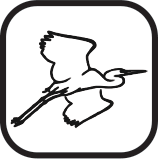Citizen Science Resources for Bird Conservation
Citizen Science Resources for Bird Conservation
We invite you to become part of the Kushlan Bird Conservation Program and help us ensure the health and vitality of bird populations for future generations.
You can contribute to bird conservation efforts using the citizen science resources listed here. Through citizen science, anyone can help with collecting, analyzing, and sharing scientific data. This makes science more inclusive and allows more people to contribute to important discoveries. Citizen science initiatives are critical for tracking bird population trends, monitoring changes in bird distribution and behavior, and identifying species at risk. By engaging in these projects, you become an essential part of a collaborative effort that spans the community and beyond, enabling the collection of extensive and diverse data that would be unachievable by scientists alone.
Among these resources, eBird stands out as the most important tool for our efforts, serving as the central repository for bird observations at Fairchild. It provides a comprehensive and user-friendly platform for recording bird sightings and contributing to a global database. While eBird is our primary resource, iNaturalist and Climate Watch are also valuable tools that complement our data collection.
eBird is a global birding community where bird enthusiasts can record their sightings and contribute to a vast database of bird observations. Designed to be user-friendly, eBird makes it easy for nonprofessionals to participate by providing simple tools for recording and submitting bird sightings through both its website and mobile app. This accessible platform encourages widespread participation, which significantly enriches the database with a large volume of observations from diverse locations. The information collected through eBird helps scientists in numerous ways: it allows them to track bird migration patterns by analyzing where and when different species are observed, monitor population changes to identify species that may be increasing or declining in number, and study the distribution of birds to understand their habitats and ranges. This valuable data is crucial for conservation efforts, enabling scientists to identify areas of concern, develop effective protection strategies, and make informed decisions to preserve bird species and their environments. By contributing to eBird, you can play a vital role in advancing scientific research and conservation efforts globally.
How to Participate
Download the eBird app from the App Store or Google Play, or visit eBird.org.
Getting Started
- Create an account on the eBird website or app.
- Start recording your bird observations.
- Submit your sightings to contribute to the global database.
iNaturalist is a community of naturalists, scientists, and citizens working together to map and share observations of biodiversity across the globe. This platform is designed to be accessible and user-friendly, making it easy for anyone, regardless of their expertise, to document and share their observations of the natural world. By simply taking photos of birds and other wildlife and uploading them to the iNaturalist website or mobile app, users can contribute valuable data to a global database. This collaborative effort helps to map the distribution of species, track changes in biodiversity, and document new and rare sightings. Scientists use the data collected through iNaturalist to monitor species distributions, understand ecological changes, and identify conservation priorities. The platform also includes tools for species identification, where the community can help verify and suggest identifications, ensuring the accuracy of the data. By participating in iNaturalist, users not only contribute to important scientific research but also engage in a community-driven effort to protect and understand the rich biodiversity of our planet.
How to Participate
Download the iNaturalist app from the App Store or Google Play, or visit iNaturalist.org.
Getting Started
- Create an account on the iNaturalist website or app.
- Upload your bird photos and observations.
- Identify the species or get help from the community to identify them.
Climate Watch is a program by the National Audubon Society that engages volunteers in surveying birds to understand how climate change is affecting bird populations. This initiative is designed to be inclusive and straightforward, making it easy for volunteers, regardless of their birdwatching experience, to participate. Volunteers are trained to conduct surveys during specific periods in winter and summer, focusing on target species that are indicators of climate change impacts. The data collected from these surveys is crucial for scientists studying the effects of climate change on bird populations, such as shifts in their ranges, changes in migration patterns, and variations in population sizes. By analyzing this data, scientists can identify trends and make predictions about how different bird species will respond to ongoing climate changes. This information is vital for developing conservation strategies and policies aimed at protecting birds and their habitats. Through Climate Watch, volunteers become part of a nationwide effort to understand and mitigate the impacts of climate change on birds.
How to Participate
Visit audubon.orgGetting Started
- Sign up to participate in the surveys conducted during winter and summer.
- Follow the survey guidelines to count birds and record your observations.
- Submit your data to Audubon for analysis.



